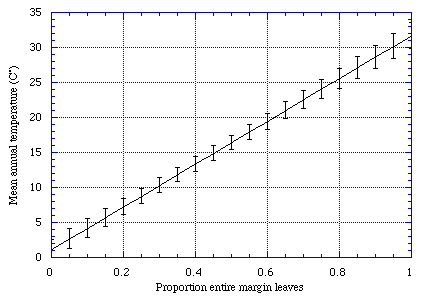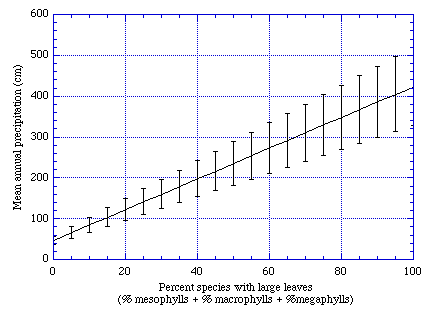![[Laboratory XI - Interpreting past Climate from Fossil Leaf Assemblages]](ClimD/ClimfontB.jpeg)
![[Laboratory XI - Interpreting past Climate from Fossil Leaf Assemblages]](ClimD/ClimfontB.jpeg)
The Buffalo Canyon Flora is of mid-Miocene age and was collected from central Nevada. During the Miocene, this region was dotted by a series of lakes that offer us an extensive record of the shoreline vegetation. At Buffalo Canyon, fossiliferous sediments are composed almost entirely of diatoms, the shells of microscopic lake creatures. The presence of diatoms and the near absence of clays and mud in the Buffalo Canyon sediment suggests that water of the lake was cool and clear. The fossils were probably washed into the lake by streams or blown into the lake by winds. Their abundance and good preservation imply rapid burial.
The flora was described by the late Daniel I. Axelrod in 1991. Axelrod applied the 'Nearest Living Relative' approach to interpret its Miocene climate. The flora as described by Axelrod includes 69 species, many of which are represented by a single specimen. The flora includes 12 conifer taxa, one monocot and 55 dicots. It is dominated by Quercus hannibalii (VG 1:10)(2,191 specimens out of 8,276 total specimens), Betula desatoyana (VG 1:3)(2,128 specimens), a Zelkova species (Ulmaceae (VG 1:16)) (744 specimens). In addition there are many conifers, which together constitute about 8% of the flora. Based on comparisons with modern relatives of the fossil taxa, Axelrod concluded that the climate associated with the Buffalo Canyon flora had a MAT of about 10°C and a MAP of 89-100 cm. These interpretations are based on the presence of Zelkova and some other species, which today only occur in temperate and fairly moist environments. Furthermore, comparison with modern relatives also led Axelrod to conclude that the Buffalo Canyon flora had ample summer rainfall, because Zelkova today only occurs in areas with summer rain. However, the Buffalo Canyon flora is dominated by Quercus hannibalii, which is considered to be closely allied to the extant Q. chrysolepis . Today, Q. chrysolepis is found in environments that typically receive an average of 50 cm of rain and in areas characterized by winter rain and summer drought.
Because the leaves and conifer seeds were transported into the lake before preservation, it is difficult to reconstruct vegetation and distribution of the plant species as they might have grown on the landscape. Some horizons are rich in cat-tail (Typha) leaves, suggesting that these plants grew along the lake margin. However, how could you know whether the winged spruce (Picea) seed came from a tree growing close to the edge of the lake or from a site a considerable distance away? Also, some plant species may be over-represented in the fossil flora, because they grew on the lake margin.
Axelrod believed that the vegetation at Buffalo Canyon was most similar to the western mixed conifer forests of lower elevations of the western United States, as well as eastern conifer-deciduous forests in the United States and Asia. He believed that the best modern analog to Buffalo Canyon was the forests of the Klammath Mountains of northwestern California.
From data you collect on an assemblage of Miocene leaves, you will deduce two climatic parameters: (1) mean annual temperature (MAT), and (2)mean annual precipitation (MAP).
Work as a group for this exercise. As you work, discuss the features you use to separate individual fossils in your collection into species and your observations of climatically-important leaf features. Are these two sets of features the same or different?
The first step is to sort the approximately 300 dicot leaf specimens into appropriate taxa. There is no magic formula for doing this. Basically what you will do as a group is spread the specimens out and try to group those that look alike into form species. Look at overall leaf shape, size, venation patterns, the shape of lobes and teeth and so on, as characters to help you divide taxa into form species. Once you have decided on your taxonomic groupings, consult Axelrod (1991) to try to place names with your taxa. Don't worry if your taxonomy doesn't agree with Axelrod's. The important point is to have the experience of trying to recognize and defend taxa. Peter Wilf's method is an 'ataxonomic approach', so why do you need to sort your collection into form taxa?
Once you have sorted your specimen into form species you will score each form species the following way:
A tooth is a vascularized extension of the leaf margin, with a corresponding sinus incised not more than one quarter the distance from margin to midrib. Lobed leaves without teeth are scored as entire. Lobes are extensions of margin in which the sinus extends more than one quarter the distance from margin to midrib.
From your scoring you will determine the proportion of entire margined leaf species (P). With that information you can determine the leaf-estimated-MAT on Figure 11.1 of using the following equation:
MAT = (30.6 * P) + 1.14
For an error estimate you can use the error bars, but note that the error bars in Figure 11.1 were calculated by maximizing r, the number of species. Since the teaching collection is somewhat limited, you will probably have a small number of species. Because this sampling bias (small number of species) can introduce error in your calculation of MAT, you may want to calculate the standard deviation of your leaf-estimated MAT:

c = slope of regression = 30.6
r = number of species

|
| Figure 11.1.
|
Precipitation is more difficult to deduce from physiognomic characters because the plant responds to the relative moisture conditions, not absolute precipitation as might be measured by a rain gauge or fog trap. For example, when temperature, and thus evaporation, are high, more precipitation must fall to create the net water surplus recognized by the plant than would be required in a cooler climate. However, leaf area may be a useful indicator of precipitation. Leaves have a high surface to volume ratio and they transpire from the stomata that are distributed over the surface of the leaf. This is why leaves tend to be small in hot, dry climates and larger in wetter climates.
Once you have sorted your collection into form taxa you will determine the largest and smallest specimen of each form species. Because you are dealing with fossils this may be problematic; the larger a fossil specimen, the higher the probability that the specimen will be broken at some point during its taphonomic history. There are many different ways one could deal with that problem. As a group discuss alternatives and decide which method you will use. The important thing is that you apply that method consistently in order to minimize error.
For the largest and smallest specimen of each form species perform the following calculations:
Next use the table of the Raunkier-Webb size categories to determine the size classification for each form species:
| ln(leaf area [mm] ) | size category |
| less than 2 to 3.2 | leptophyll |
| 3.2 to 5.7 | nanophyll |
| 5.7 to 7.6 | microphyll |
| 7.8 to 8.4 | notophyll |
| 8.4 to 9.8 | mesophyll |
| 9.8 to 12 | macrophyll |
| larger than 12 | megaphyll |
Now calculate the percent of species with mesophylls + macrophylls + megaphylls and use the graph in Figure 11.2 or the equation that follows to determine MAP.
One disadvantage of this method is that error for MAP cannot be determined.
Now that you have developed your own climate interpretation of the Buffalo Canyon flora, how does it compare to Axelrod's (1991)? Discuss the results of this analysis relative to that of the Nearest Living Relative approach.

|
| Figure 11.2.
|
In addition to the Buffalo Canyon Flora, we have collected five other Tertiary (mostly Neogene) floras from Western North America with which you can compare the Buffalo Canyon flora and its inferred climate. We have talked in lecture about climate change during the Tertiary in Western North America. Do these floras reflect the general conclusions that have been drawn? What sorts of taphonomic biases might be confounding the picture?
Chalk Bluffs Flora -- Eocene
Goshen Flora -- Early Oligocene
Bridge Creek Flora -- Middle Oligocene
Buffalo Canyon Flora -- Early Miocene
Hidden Lake Flora -- Middle Miocene
Collawash Flora -- Late Miocene
![[Previous Page]](../VPLimg/Back.jpeg) |
![[Title Page]](ClimD/Climbutt.jpeg) |
![[Glossary]](../VPLimg/Glossbutt.jpeg) |
![[Geologic Time Scale]](../VPLimg/timesbutt.jpeg) |
![[Next Page]](../VPLimg/Forward.jpeg) |

